.jpg)
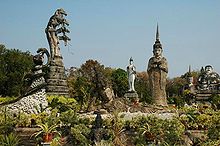
.jpg)

Mucalinda, Muchalinda or Mucilinda is the name of a naga (a snake-like
being), who protected the Buddha from the elements after his enlightenment.
It is said that four weeks after Śākyamuni Buddha began meditating under the
Bodhi tree, the heavens darkened for seven days, and a prodigious rain
descended. However, the mighty king of serpents, Mucalinda, came from beneath
the earth and protected with his hood the one who is the source of all
protection. When the great storm had cleared, the serpent king assumed his human
form, bowed before the Buddha, and returned in joy to his palace.
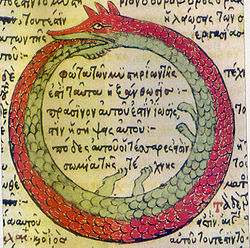
The Ouroboros or Uroborus is an ancient symbol depicting a serpent or dragon
swallowing its own tail and forming a circle.
The Ouroboros often represents self-reflexivity or cyclicality, especially in
the sense of something constantly re-creating itself, the eternal return, and
other things perceived as cycles that begin anew as soon as they end (compare
with phoenix).
Carl Jung interpreted the Ouroboros as having an archetypal significance to the
human psyche. The Jungian psychologist Erich Neumann writes of it as a
representation of the pre-ego "dawn state", depicting the undifferentiated
infancy experience of both mankind and the individual child.[2]
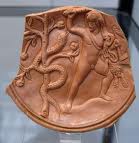
In Greek mythology Ladon coiled around the tree in the garden of the
Hesperides protecting the entheogenic golden apples. It was slain by Heracles.

Similarly Níðhöggr (Nidhogg or Nagar) the dragon of Norse mythology eats from
the roots of the Yggdrasil the World Tree.
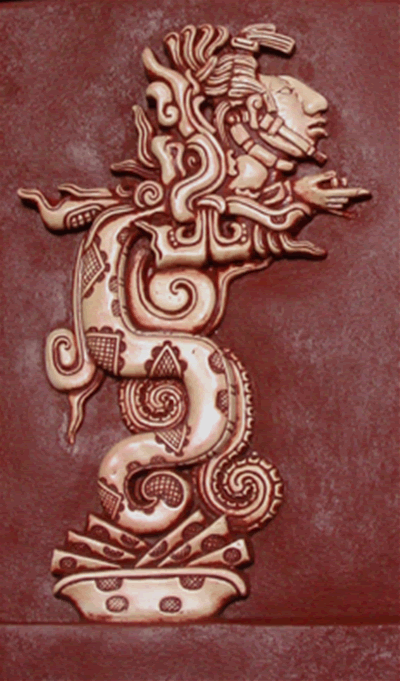
The Vision Serpent was also a symbol of rebirth in Mayan mythology, fuelling some cross-Atlantic cultural contexts favored in pseudoarchaeology. The Vision Serpent goes back to earlier Maya conceptions, and lies at the center of the world as the Mayans conceived it. "It is in the center axis atop the World Tree. Essentially the World Tree and the Vision Serpent, representing the king, created the center axis which communicates between the spiritual and the earthly worlds or planes. It is through ritual that the king could bring the center axis into existence in the temples and create a doorway to the spiritual world, and with it power". (Schele and Friedel, 1990: 68)

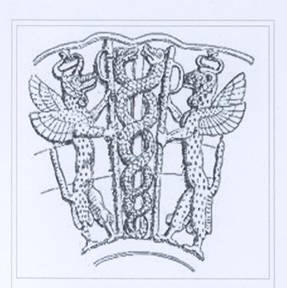
In the Louvre, there is a famous green steatite vase carved for king Gudea of
Lagash (dated variously 2200–2025 BCE) with an inscription dedicated to
Ningizzida. Ningizzida was the ancestor of Gilgamesh, who according to the epic
dived to the bottom of the waters to retrieve the plant of life. But while he
rested from his labor, a serpent came and ate the plant. The snake became
immortal, and Gilgamesh was destined to die.


In Ancient Egypt, where the earliest written cultural records exist, the serpent appears from the beginning to the end of their mythology. Ra and Atum ("he who completes or perfects") became the same god, Atum, the "counter-Ra," was associated with earth animals, including the serpent: Nehebkau ("he who harnesses the souls") was the two headed serpent deity who guarded the entrance to the underworld. He is often seen as the son of the snake goddess Renenutet. She often was confused with (and later was absorbed by) their primal snake goddess Wadjet, the Egyptian cobra, who from the earliest of records was the patron and protector of the country, all other deities, and the pharaohs. Hers is the first known oracle. She was depicted as the crown of Egypt, entwined around the staff of papyrus and the pole that indicated the status of all other deities, as well as having the all-seeing eye of wisdom and vengeance. She never lost her position in the Egyptian pantheon.
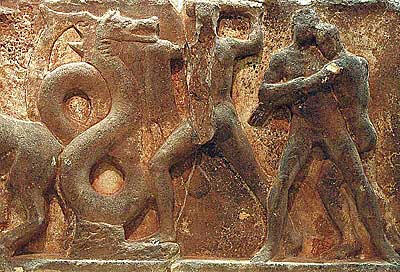
Apollo famously killed the Python, a female serpent which guarded Delphi, the holy seat of Gaia. After slaying the Python, Apollo adopted Delphi as his own sacred space.
The world tree is a motif present in several religions and mythologies, particularly Indo-European religions. The world tree is represented as a colossal tree which supports the heavens, thereby connecting the heavens, the earth, and, through its roots, the underground. It may also be strongly connected to the motif of the tree of life.
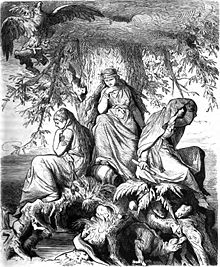
Specific world trees include the one in Hungarian mythology, Yggdrasil (or
Irminsul) in Norse mythology, the Oak in Slavic and Finnish mythology, and in
Hinduism the Ashvastha (a Sacred Fig).
The Tree of Jiva and Atman appears in the Vedic scriptures, predating current
Hinduism, as a metaphysical metaphor concerning the soul.
The Rig Veda samhita 1.164.20-22, Mundaka Upanishad 3.1.1-2, and Svetasvatara
Upanisad 4.6-7, speak of two birds, one perched on the branch of the tree, which
signifies the body, and eating its fruit, the other merely watching.
Rig Veda samhita says:
1.164.20 Two birds associated together, and mutual friends, take refuge in the
same tree; one of them eats the sweet fig; the other abstaining from food,
merely looks on.
1.164.21 Where the smooth-gliding rays, cognizant, distil the perpetual portion
of water; there has the lord and steadfast protector all beings accepted me,
though immature in wisdom.
1.164.22 In the tree into which the smooth-gliding rays feeders on the sweet,
enters, and again bring forth light over all, they have called the fruit sweet,
but he partakes not of it who knows not the protector of the universe.
The first bird represents a Jiva, or individual self, or soul. She has a female
nature, being a sakti, an energy of God. When the jiva becomes distracted by the
fruits (signifying sensual pleasure), she momentarily forgets her lord and lover
and tries to enjoy the fruit independently of him. This separating forgetfulness
is maha-maya, or enthrallment, spiritual death, and constitutes the fall of the
jiva into the world of material birth, death, disease and old age.
The second bird is the Paramatman, an aspect of God who accompanies every living
being in the heart while she remains in the material world. He is the support of
all beings and is beyond sensual pleasure.
It is significant to note that this concept of Atman and Jiva have been
personified and taken into the Bible as Adam and Eve and the fall of man.
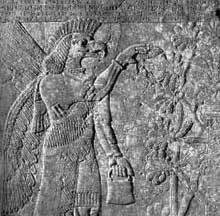
Inanna (Sumerian goddess of fertility; Babylonian Ishtar) planted the Huluppu Tree and placed a serpent there to guard it. Anzu (a bird demon who stole the tablets of destiny) placed his young in the tree. Lilith (a rebellious female demon) lived in the tree. Gilgamesh killed the serpent, Anzu's young, and Lilith, after which he chopped down the tree and made a throne of it which he dedicated to Inanna.

Clay cylinder depicting unknown woman and god at banquet with snakes and tree of life
Works Cited:
"World Tree" (http://en.wikipedia.org/wiki/World_tree)
"Tree of Knowledge of Good and Evil" (http://en.wikipedia.org/wiki/Tree_of_the_Knowledge_of_Good_and_Evil#Trees_in_other_religions)
"Serpent (Symbolism)" (http://en.wikipedia.org/wiki/Serpent_%28symbolism%29#Guardianship)
"Ouroboros" (http://en.wikipedia.org/wiki/Ouroboros)